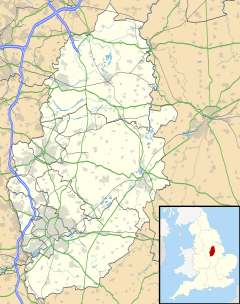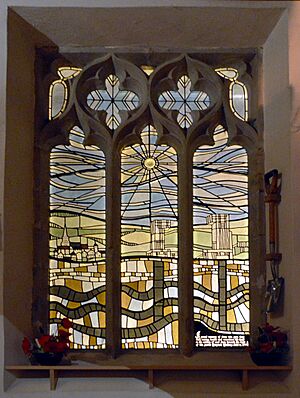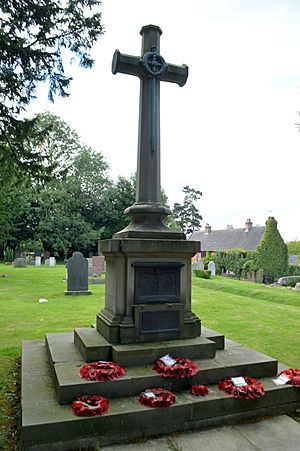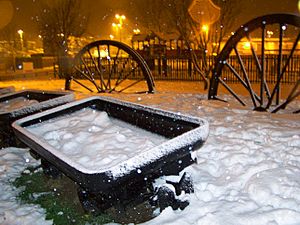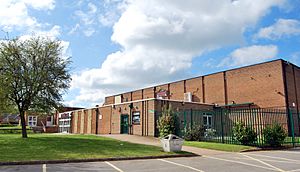Cotgrave facts for kids
Quick facts for kids Cotgrave |
|
|---|---|
| Town and civil parish | |
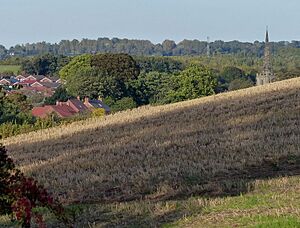 Skyline of Cotgrave with spire of All Saints' Church |
|
Parish map |
|
| Area | 5.96 sq mi (15.4 km2) |
| Population | 8,206 (2021) |
| • Density | 1,377/sq mi (532/km2) |
| OS grid reference | SK 64412 35640 |
| • London | 105 mi (169 km) SSE |
| District |
|
| Shire county | |
| Region | |
| Country | England |
| Sovereign state | United Kingdom |
| Post town | NOTTINGHAM |
| Postcode district | NG12 |
| Dialling code | 0115 |
| Police | Nottinghamshire |
| Fire | Nottinghamshire |
| Ambulance | East Midlands |
| EU Parliament | East Midlands |
| UK Parliament |
|
Cotgrave is a town and civil parish located in Nottinghamshire, England. It is about 5 miles (8 km) south-east of the city of Nottingham. The town sits on the South Nottinghamshire Wolds, around 131 feet (40 metres) above sea level. In 2021, the population of Cotgrave was 8,206 people.
Contents
Discovering Cotgrave's Past
Cotgrave has a very long history. Its beginnings might go back to the Iron Age. Archaeologists found an Anglo-Saxon burial ground from the 6th century near the old village. There was even a Saxon church here before the Norman Conquest in 1066.
The ancient Roman road, Fosse Way, runs about a mile to the east of Cotgrave. During road improvements in 2012–13, workers found Ice Age flint tools. They also discovered an Iron Age settlement nearby. Even older, a 4,000-year-old circular monument from the Neolithic period was found, with eight Bronze Age burials.
The name Cotgrave likely comes from an old English personal name, Cotta, combined with grāf, which means grove or copse. So, it means 'Cotta's grove'.
All Saints' Church: A Historic Landmark
The main church in Cotgrave, All Saints', was built in the 12th century. It has been changed and added to many times since then. In 1996, a fire caused a lot of damage, but the church has been beautifully restored. It has eight bells that are regularly rung by a team.
In 1637, a serious illness affected the village, causing many deaths. The church was used to store food for the villagers during this time. Money for goods was disinfected by passing it through a special hollowed stone filled with vinegar. This stone is still in the church today!
Near the church, there's an old wall called the "Thousand-Year Wall." It has many small holes that are home to a large group of solitary bees. A nearby graveyard, separated from the church by a road, has a pillar honoring those from the village who died in the world wars. The church also has a stained-glass window from 1920 that remembers these soldiers. Another window shows the Cotgrave Colliery, which was a coal mine in the area.
Remembering Heroes: War Memorials
Cotgrave has a special war memorial in the graveyard on Scrimshaw Lane. It honors the people from the village who lost their lives in both the First World War and the Second World War. The memorial lists twelve men from the First World War and four from the Second World War. A local group works to research and remember these brave individuals.
The memorial also features an epitaph that reads: "Be thou faithful unto death and I will give you a crown of life." This is often called the Cotgrave Cross. There is another monument, also called the Cotgrave Cross, at the east end of the church. Its history is a bit of a mystery, as it looks ancient but only appeared in photos in the early 20th century.
Another memorial plaque made of oak is inside All Saints' Church. There is also a stained glass window dedicated to remembrance.
To the north of Cotgrave, near the golf course, there is a memorial to a Vickers Wellington bomber plane. This plane crashed on February 8, 1941, during a training flight, killing seven crew members. A plaque marks the spot where it hit an oak tree.
Famous Faces from Cotgrave
Cotgrave has been home to some interesting people:
- William Upton (1804–1867): A county cricketer for Nottinghamshire. He was born and died in Cotgrave.
- Elinor Mordaunt (1872–1942): A well-known writer and traveler. She was born in Cotgrave.
- Ernest Hayes (1898–1938): Born in Cotgrave, he was a brave soldier in the First World War. He received the Military Medal three times for his courage in France in 1918.
- Frank Robinson (1932–2004): Known as the "Xylophone Man," he traveled daily to Nottingham to play a child's five-note glockenspiel. Many people loved listening to him.
- Nathan Robertson (born 1977): A famous badminton player. He won a World Championship in mixed doubles in 2006, an Olympic Silver Medal in 2004, and a Commonwealth Games silver medal in 2010. He grew up in Cotgrave and went to the local school.
Cotgrave Colliery: The Coal Mine Story
Cotgrave is located near the Grantham Canal, which opened in 1797. For many years, people tried to find coal in the area, but it wasn't until around 1950 that it was discovered. The Cotgrave Colliery (a coal mine) was built in the early 1960s.
Many miners and their families moved to Cotgrave from other mining areas of England, especially the North East. They came to live in new houses built just for them. This caused the village's population to grow from about 700 to over 5,000 in just a few years! A special railway line was even built in 1960 to connect the colliery to the main railway.
The mine's head towers were very modern for their time. Miners also had great changing and shower facilities, so they could leave work as clean as they arrived.
The mine closed in 1993–94, which was a difficult time for the local economy. Many people felt sad and betrayed because the mine still had millions of tons of coal. However, it was closed due to geological problems, like underground streams causing floods, and the coal seams becoming too far from the shafts, making it too expensive to dig. After it closed, the shafts were filled with concrete, and all the buildings were taken down.
Since then, Cotgrave's economy has improved a lot. Many of the miners who moved here from the North East stayed, built homes, and raised their families in Cotgrave.
Modern Cotgrave: Amenities and Community
Cotgrave has a shopping area called the Precinct. It has a Co-op supermarket, a library, and various takeaway restaurants. This area was updated between 2017 and 2020. New buildings were put up, and a multi-service center now houses the library, a medical center, a pharmacy, and a police station. There's also a new children's play area and more parking.
Besides All Saints' Church, Cotgrave has a Methodist chapel (from 1802) and a Roman Catholic church. You can also find a small Sainsbury's Local store and a café called The Pig and Pudding.
The leisure center in Cotgrave has a large swimming pool, a gym, and a sports hall with playing fields. There are also two allotment areas where people can grow their own fruits and vegetables. Cotgrave Community Gardens is a volunteer-run project for growing food together.
Cotgrave has two primary schools: Cotgrave Candleby Lane School and Cotgrave Church of England (Aided) Primary School. The Church of England school first opened in 1720! There's also Ash Lea School, which is a special school for students with complex learning difficulties.
You can find two pubs in Cotgrave: the Manvers Arms and the Rose and Crown. A third pub, the Black Diamond, closed in 2006 and was replaced by houses.
Community Spirit and Sports
The Cotgrave Club, also known as the Miners' Welfare Club, is a large building with several bars, snooker rooms, and entertainment areas. It has one of the biggest stages in the region and can host hundreds of people. The club is available for hire for events.
The club also has cricket and football teams, with enough grounds for two football matches at once. There are changing rooms and facilities for both home and visiting teams. Cotgrave also has an angling (fishing) club. The town has hosted the Cotgrave Festival of Sports, a week of sporting events for the whole community.
There's also a Kickboxing club at the Cotgrave Leisure Centre. The community also has a website, run by the council and local residents, where people can connect and share information.
Cotgrave Country Park: Nature's Retreat
The large area where the coal mine used to be has been turned into a beautiful country park. A long part of the Grantham Canal has been partly restored, including some locks. While it's not currently used for boats, there are plans to bring the canal back to life. The old mine area might even become a marina someday.
The park now has many trees that are growing well, and it's home to lots of different wildlife. You can see many kinds of birds, like cuckoos, swallows, and herons. There are also great crested newts in the lake, as well as hares, rabbits, foxes, bats, and owls. The lake is full of fish and is popular with anglers.
The park offers picnic areas, car parks, a special path for horse riders, and a nature trail. You can walk through woodlands, by the lake, and along the old railway track. A small section of the original rails and sleepers has even been left in place. A group of volunteers called Friends of Cotgrave Country Park helps to look after and improve the park. They even helped build a swimming pool for dogs, to keep them away from the sensitive wildlife in the lake!


